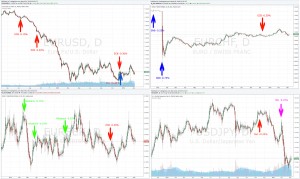Negative Interest Rate Policy: No lasting effect on FX
14-04-2016 | by Simon Knappstein |

Negative interest rates are gripping Central Banks worldwide. The BoJ has resorted to this unexpected and unusual policy at the end of January. The ECB is expected to dig deeper into negative realms at their March meeting. The Swedish Riksbank has also gone negative and the Fed is contemplating the possibility for the eventuality economic growth will falter and inflation will fall. And of course the Swiss are already quite accustomed to negative interest rates. But in the FX markets the effects are minimal and short-lived.
So, are Central banks reaching the end of the effectiveness of their extremely loose monetary policies? If so, the big question is what next? Plain currency intervention? Hard to imagine currently, though the Swiss National Bank is said to be continuously intervening to prop up EUR/CHF.
The ECB has crossed the zero interest rate border in the summer of 2014 bringing its depo-rate to minus 0.10%. A move intended to stimulate credit growth by commercial banks, and as a means to lower the value of the Euro as to import more inflation. Although the latter was not explicitly mentioned everyone knows it was.
Since then the Swiss National Bank in December 2014, the Riksbank in February 2015 and the Bank of Japan in January 2016 have followed suit by introducing negative interest rates.
Currency impact

Figure 1 – Currency impact
The impact on the currency exchange rate is questionable and certainly not a straightforward main driver, as can be seen in figure 1.
When the ECB introduced a negative interest rate in the summer of 2014 it was accompanied by the start of the QE program and indeed EUR/USD moved considerably lower. The rate cut to -0.3% last December had no material impact on the exchange rate, even though it was followed by the first Fed rate hike in years.
The pressure on EUR/CHF could not be relieved by a rate cut to -0.25% in December 2014 so it was soon followed by the abandoning of the minimum exchange rate at 1.20 and a further cut to -0.75%. EUR/CHF stabilized but only continuous intervention by the SNB has brought the pair higher since then. The charts for EUR/SEK and USD/JPY speak for itself.
The conclusion is that there is very little to no evidence that negative interest rates lead to weaker currencies to support inflationary pressures.

Owner of FX Prospect


